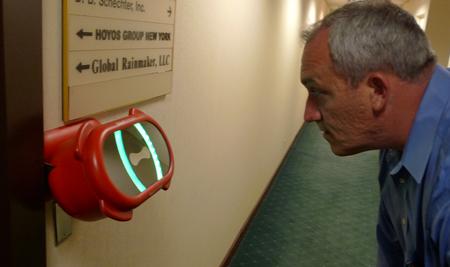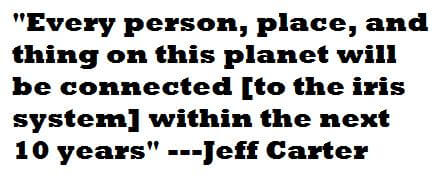
The million-plus citizens of Leon, Mexico are set to become the first example of a city secured through the power of biometric identification. Iris and face scanning technologies from Global Rainmakers, Inc. will allow people to use their eyes to prove their identify, withdraw money from an ATM, get help at a hospital, and even ride the bus. GRI’s eye scanning systems aren’t more secure than others on the market, but they are faster. Large archway detectors using infrared imaging can pick out 50 people per minute, even as they hustle by at speeds up to 1.5 meters per second (3.3 mph). The first phase of the Leon iris and face scanning project has already begun. It is estimated to cost around $5 million and focuses on law enforcement agencies’ security check points. Over the next three years commercial uses will be rolled out with banks leading the charge. Check out the videos below to see GRI’s wide range of iris scanning stations in action. Whether you’re jealous or intimidated by Leon’s adoption of widespread eye identification you should pay attention to the project – similar biometric checkpoints are coming to locations near you. Some are already in place.
When it comes to biometric identification, fingerprints are the most widespread and trusted technology. Yet they only contain a few dozen data points to link to your ID. Irises, in contrast, have around 2000 points of reference – enough to uniquely identify every person on Earth. Many companies have developed the means to take an iris scan and use these reference points to match them quickly to a database of scans. The problem has typically been that getting the image of the iris itself is slow and requires people to come very close to the scanning device. GRI has focused on improving the iris acquisition side of the technology, increasing the speed and range of their devices. Not only that, but they are bringing the costs down. A 30 person per minute device (the HBox Mini) costs around $48,000. Yet smaller devices, ones suitable for ATMs or desktop computers are falling below $2000. As they become faster and more affordable, the adoption of iris scanners is seemingly becoming more inevitable as well.
Here’s a demo of the larger devices from GRI. Notice that masks and sunglasses are generally not going to deter a scan:
The HBox V provides rapid access to restricted areas for those in cars at a rate around 12 people per minute.
Smaller devices like the EyeSwipe and EyeSwipe Mini could work for secured locations in an office. According to Fast Company, this scale of iris scanning tech is in place in Bank of America’s headquarters in Charlotte.
The HCam would provide a means of iris identification for computers and ATMs.
My apologies for showing so many different videos of GRI technology but I wanted to give you an idea of how completely the company has encompassed the application space for iris and face scanning. From large foot trafficked areas, to automobiles, to home use they’ve got it covered. They don’t have a handheld portable scanner that I’ve seen…but give them time and they’ll probably develop that as well.
This makes me believe GRI’s implementation in Leon is eventually going to exceed anything we’ve seen before. Every other means of access (license, credit card, keys, etc) has the potential of being augmented or replaced by iris and face scanning. Get on a bus, pass security on the way into work, pay for a meal, order packages online – all without using anything besides your eye. The Leon project could make this futuristic world appear in just 3 to 5 years. That’s incredible.

We have to put this in a larger context, too. India just launched its enormous effort to digitally identify more than a billion residents using fingerprints, face, and iris scans. Japan already uses finger scans during entry into the country. The EU is working on a variety of passive scanning technologies to help secure airports and other public spaces.
To some these emerging applications must seem like the sign of a privacy apocalypse. Government and commercial institutions will endeavor to create enormous shared databases of biometric data and scan huge numbers of private citizens everywhere they go. The first phase of the project in Leon is going to help track the movements of ‘watch-listed individuals’. Rapid scanning face and iris scanning technologies will redefine our sense of privacy in ways that make Big Brother seem like a little sissy.
Jeff Carter, chief business development officer of GRI, didn’t make any of this sound less threatening in his interview with Fast Company’s Austin Carr:
“…we’ve even worked with three-letter agencies on technology that can capture 30-plus feet away. In certain spaces, eventually, you’ll be able to have maybe one sensor the size of a dime, in the ceiling, and it would acquire all of our irises in motion, at a distance, hundreds–probably thousands as computer power continues to increase–at a time.”
“…If you’ve been convicted of a crime, in essence, this will act as a digital scarlet letter. If you’re a known shoplifter, for example, you won’t be able to go into a store without being flagged. For others, boarding a plane will be impossible.”
For commercial applications it’s just as incredible:
“Right now, we can determine how many eyeballs are on a Web page. And what you look at and click. For the first time, we can do that in a physical world. If you look at this or that advertisement, and then go purchase the product advertised, we can tie those two things together.”
“When you get masses of people opting-in, opting out does not help. Opting out actually puts more of a flag on you than just being part of the system. We believe everyone will opt-in.”
Does that vision sound ominous to you? It does to me, and I’m pretty biometric friendly. Yet I’m also fairly cynical. People already have a pretty good handle on my information. Google reads all my emails, albeit in an anonymous way. My bank knows most everything I buy, ditto for credit card companies. As Carter points out, I already deal with these commercial trackers every day. And I’ve opted into these systems. I could pay for everything with cash, but I find the convenience of plastic too great to ignore. While I’m worried about being verbally assaulted by billboards that try to identify me, they’re going to arrive whether I want them to or not.
Rather than fight the advent of biometrics, I’d rather focus on controlling how such data is used. We can pressure governments to insure that people are not unjustly placed on watch-lists. We can require businesses to divorce our identities from collected data to make advertisements anonymous even as they are personalized. We can limit who can use these technologies, and how, even as we accept that they will be widely adopted in the future. Now is the time, as the first cities test the feasibility of biometric ID systems, to ensure that they will be used to benefit rather than restrict the individual. The crucial moment to guide the path of this emergent technology has arrived. Blink and you could miss it.
[image credits: Austin Carr/Fast Company]
[source: GRI, Fast Company]



